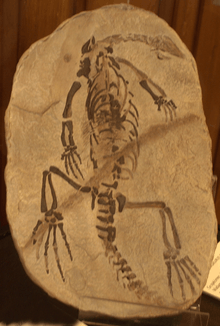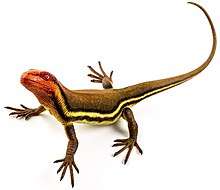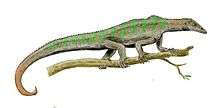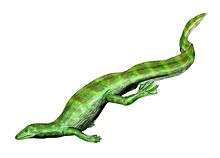Neodiapsida
Neodiapsida is a clade, or major branch, of the reptilian family tree and includes all diapsids apart from some early primitive types known as the araeoscelidians.
| Neodiapsids | |
|---|---|
 | |
| Fossil of an early neodiapsid (Claudiosaurus germaini), Redpath Museum | |
| Scientific classification | |
| Kingdom: | Animalia |
| Phylum: | Chordata |
| Class: | Reptilia |
| Clade: | Diapsida |
| Clade: | Neodiapsida Benton, 1985 |
| Subgroups | |
| |
In phylogenetic systematics, they are variously defined as the common ancestor and all its descendants of Younginiforms and "crown diapsids" (the common ancestor of lizards, crocodilians and birds, and all their descendants) [Callaway 1997], or all diapsids that are more closely related to Sauria than to Araeoscelidia (Laurin and Gauthier 2000).
Early or basal Permian neodiaspids were lizard-like, but already include specialised forms for swimming (Claudiosaurus) and gliding (Coelurosauravidae), as well as more conventional lizard-like forms (Youngina etc.). Before the end of the Permian, the neodiapsids give rise to the main branches of the diapsid evolutionary tree, the lepidosaurs and archosaurs.
Classification
The clade Neodiapsida was given a phylogenetic definition by Laurin in 1991. He defined it as the branch-based clade containing all animals more closely related to "Younginiformes" (later, more specifically, emended to Youngina capensis) than to Petrolacosaurus.[1] The cladogram presented here illustrates the "family tree" of reptiles, and follows a simplified version of the relationships found by M.S. Lee, in 2013.[2] All genetic studies have supported the hypothesis that turtles are diapsid reptiles; some have placed turtles within archosauromorpha,[2][3] or, more commonly, as a sister group to extant archosaurs.[4][5][6][7] though a few have recovered turtles as lepidosauromorphs instead.[8] The cladogram below used a combination of genetic (molecular) and fossil (morphological) data to obtain its results.[2]
| Diapsida |
| |||||||||||||||||||||||||||||||||||||||||||||||||||||||||||||||
References
- Reisz, R. R., Modesto, S. P., & Scott, D. M. (2011). A new early permian reptile and its significance in early diapsid evolution. Proceedings of the Royal Society B, 278(1725): 3731-3737.
- Lee, M. S. Y. (2013). "Turtle origins: Insights from phylogenetic retrofitting and molecular scaffolds". Journal of Evolutionary Biology. 26 (12): 2729–2738. doi:10.1111/jeb.12268. PMID 24256520.
- Mannen, Hideyuki; Li, Steven S. -L. (Oct 1999). "Molecular evidence for a clade of turtles". Molecular Phylogenetics and Evolution. 13 (1): 144–148. doi:10.1006/mpev.1999.0640. PMID 10508547.
- Zardoya, R.; Meyer, A. (1998). "Complete mitochondrial genome suggests diapsid affinities of turtles". Proc Natl Acad Sci U S A. 95 (24): 14226–14231. Bibcode:1998PNAS...9514226Z. doi:10.1073/pnas.95.24.14226. ISSN 0027-8424. PMC 24355. PMID 9826682.CS1 maint: ref=harv (link)
- Iwabe, N.; Hara, Y.; Kumazawa, Y.; Shibamoto, K.; Saito, Y.; Miyata, T.; Katoh, K. (2004-12-29). "Sister group relationship of turtles to the bird-crocodilian clade revealed by nuclear DNA-coded proteins". Molecular Biology and Evolution. 22 (4): 810–813. doi:10.1093/molbev/msi075. PMID 15625185.
- Roos, Jonas; Aggarwal, Ramesh K.; Janke, Axel (Nov 2007). "Extended mitogenomic phylogenetic analyses yield new insight into crocodylian evolution and their survival of the Cretaceous–Tertiary boundary". Molecular Phylogenetics and Evolution. 45 (2): 663–673. doi:10.1016/j.ympev.2007.06.018. PMID 17719245.
- Katsu, Y.; Braun, E. L.; Guillette, L. J. Jr.; Iguchi, T. (2010-03-17). "From reptilian phylogenomics to reptilian genomes: analyses of c-Jun and DJ-1 proto-oncogenes". Cytogenetic and Genome Research. 127 (2–4): 79–93. doi:10.1159/000297715. PMID 20234127.
- Tyler R. Lyson; Erik A. Sperling; Alysha M. Heimberg; Jacques A. Gauthier; Benjamin L. King; Kevin J. Peterson (2012-02-23). "MicroRNAs support a turtle + lizard clade". Biology Letters. 8 (1): 104–107. doi:10.1098/rsbl.2011.0477. PMC 3259949. PMID 21775315.
- Callaway, J.M. (1997), Ichthyosauria: Introduction, in JM Callaway & EL Nicholls (eds.), Ancient Marine Reptiles. Academic Press, pp. 3–16.
- Laurin, Michel and Gauthier, Jacques A. (2000) Autapomorphies of Diapsid Clades
External links
- Eureptilia: Neodiapsida
- Neodiapsida cladogram


_(Varanus_griseus).png)




